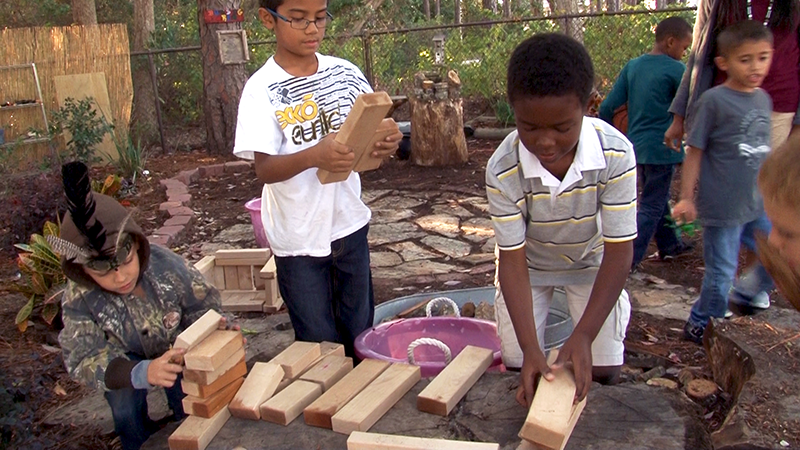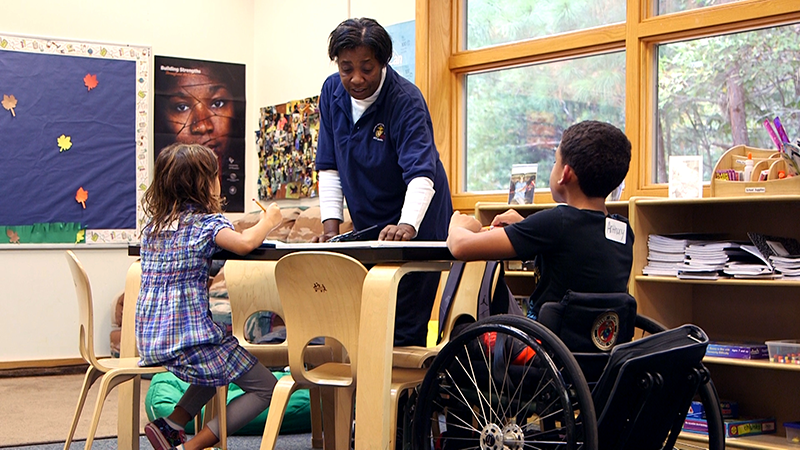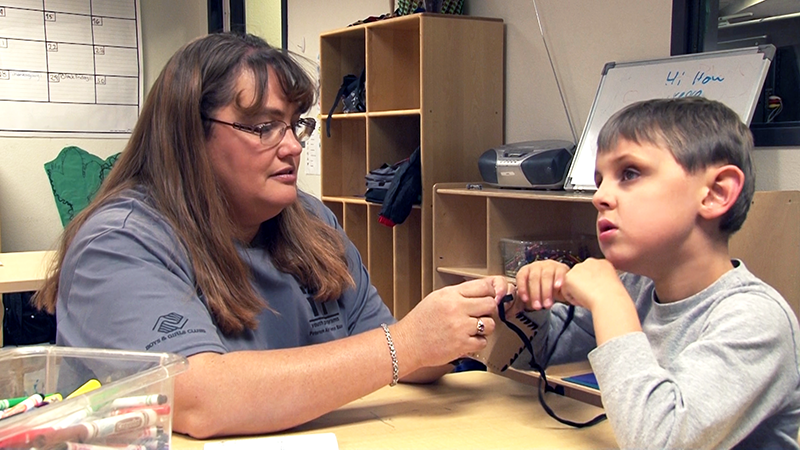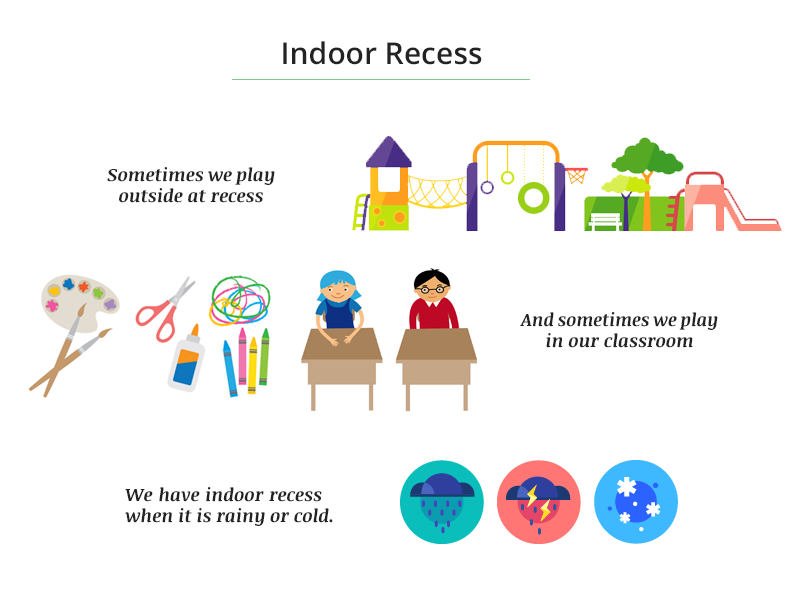- Describe the importance of play in the social-emotional development of school-age children.
- Define cooperative learning and explain how it supports social-emotional development.
- Identify the core abilities that should be included in activities and experiences that promote social-emotional development.
- Discuss how you can support the social-emotional skills of children with special learning needs in your program.
Learn
Know
The activities and experiences available in the learning environment should support the social-emotional development of school-age children. Your role will be to observe children in this environment and plan opportunities for them to play, interact, and socialize with their peers.
The Importance of Play
When observing children at play, it may appear to be all fun and games, but there is actually a lot of hard work and learning occurring. School-age children have many responsibilities and expectations during their structured school day, so in their after-school program, they need time for unstructured play. Free play allows children to use their imaginations for pretend play and to create, dream, and explore. Play is one of the most important ways children develop their social skills. Studies have shown that when children are engaged in play, they are not only having fun, but they are also working hard at the following:
- Practicing social skills such as negotiating, taking turns, sharing, compromising, expressing emotions, and listening to another’s feelings
- Learning how to participate in a conversation with another person and understanding when it is time to listen or respond
- Learning how to behave appropriately when winning or losing a game, sport, or activity
- Understanding qualities such as fairness and justice
- Learning how to follow rules and developing self-regulation
- Developing empathy and motivation
- Enhancing creativity and problem-solving skills
- Learning how to consider others’ perspective and resolve conflicts
- Improving reading achievement through dramatic play
Learning social skills occurs in nearly all play experiences; however, experiences that are dramatic or theatrical in nature provide more opportunities for children to practice social skills with their peers. Dramatic play allows children to act out real-life or fantasy scenarios and situations. As children grow, these scenes become more complex and may last days or even weeks. When interacting during dramatic play, children practice having conversations, sharing information, empathy, and teamwork.
It is crucial that children have opportunities for unstructured play each day. As a school-age staff member, it is your role to encourage children to develop their imagination and creativity. Allowing children to relax, be silly, and enjoy their downtime will give children the time they need to practice the skills they are naturally developing.
Cooperative Learning
Cooperative learning refers to a learning environment organized in groups of peers who work together toward a common goal. This type of learning is most effective when learners work together in a supportive environment under a teacher’s careful guidance. This type of learning is widely used in the school environment, and it can be used in a school-age program as well. The basis of cooperative learning is that children from a mixture of backgrounds and capabilities learn and work together toward a common goal while developing social and cognitive skills. Other benefits and outcomes of cooperative learning are:
- Children increase their friendship and respect for one another.
- Children’s self-esteem is enhanced.
- Children are motivated to participate in higher-order thinking.

You can plan opportunities for cooperative learning by having children work together on projects. Group children with varied temperaments, personalities, and capabilities so that they can learn from each other. By putting children in a small group to work toward a common goal, you help them practice the social skills necessary for real-world situations and experiences.
Activities and Experiences
As a school-age staff member, you are responsible for planning activities and experiences that help promote social-emotional development. Attached to this lesson, you will find a resource list to help plan these kinds of activities for school-age children. Although many of the resources may be focused on children who have difficulty developing social skills, all children can benefit from well-planned experiences aimed at supporting a child’s social-emotional development.
Activities and experiences that help promote social-emotional development are those that include core abilities, such as:
- Self-awareness and self-control: Children are aware of their feelings and behaviors and know how to use self-control to regulate their emotions and behaviors appropriately.
- Effective listening and observation: Children are able to participate in a conversation and understand the time for listening and responding. Children are also able to strengthen their understanding of how to read their peer’s body language and nonverbal cues.
- Knowledge of a range of emotions: Children understand a range of emotions, both of their own emotions and those of their peers, and how to respond to another’s feelings.
- Imagination: Children are able to see things from another’s perspective and empathize with others.
- Tolerance and acceptance: Children respect and celebrate differences in others.
- Problem solving: Children are able to use thinking skills to work through problems.
Although it is good practice to plan experiences and activities that directly promote the social-emotional development of school-age children, it is also important to understand that social-emotional development occurs naturally in the learning environment. Through play and learning experiences, children will interact with and observe others, which gives them the opportunity to practice their social skills and behaviors. Use conflicts and situations that arise as learning experiences for children to sit down and discuss what happened and what could have been done differently. Take time to help the children express what they are feeling to one another and always encourage an atmosphere of respect and kindness.
Addressing the Social-Emotional Needs of All Children in Your Program
Children with special needs in your program may also experience challenges with social-emotional skills. These challenges may affect the child’s ability to benefit from high-quality educational experiences and to engage in positive social interactions with peers and adults in your school-age program. Even though some challenging behaviors are typical for children, some children may show persistent challenging behaviors that can affect their overall school experience. It is important to provide children with the support they need so they can benefit as much as possible from their school experiences. For these children, you may need to adapt your curriculum, environment, and classroom experiences to enable them to be successful. Think about your activities, transitions, mealtimes, free-play time, or other program events. What are you doing during these times to ensure you address the needs of all children in your program? You should work with children’s families to ensure consistency between school and home. Families may benefit from your classroom strategies that support children’s positive behaviors.

Adaptations
Some children in your care may have conditions that affect their social-emotional development, including developmental delays, autism, neurological and perceptual disorders, or language and communication delays. Children with autism or special needs may be able to engage in play and other social interactions that have verbal prompts and directions, but other children will need visual supports, such as a visual schedule to make activities, routines, and instructions meaningful and understandable. Children with Individualized Education Programs (IEPs) have a specific plan to help them meet their education goals. Very often, these children will need changes or adaptations to the curriculum, program environment, and daily routines. You should meet with the child’s family to ensure you are supporting the child’s IEP goals within your curriculum plans.

Peer Mediation
Peer-mediated interventions involve strategies in which teachers purposefully pair children who have advanced social-emotional skills to work with children who are working at developing these skills. These strategies ensure that children have multiple opportunities throughout the day to practice social skills during routines and activities. For example, you can pair children to support practice and learning of skills such as sharing materials with a friend, reading a book with a friend, taking turns during games or activities or responding to a friend’s request to play. When considering using these strategies, you should choose peers who are socially competent, compliant with adult requests, well-liked by other children and peers, and those who have good language and play skills and like to take on the “teacher” role with peers. You can teach these children to lead their peers who are practicing and learning social skills by: responding to a peer’s request to play, helping a peer play with a game or activity, suggesting an idea for pretend play, prompting a peer to share a toy, prompting a peer to select a game or activity, or prompting a peer to take turns with an activity or toy.
Social Stories
For children who need support with understanding social situations, events, or circumstances, you may consider using social stories or scripts. These are short stories that describe social activities or behaviors to support children in learning and using appropriate social skills. They can be written by family members or teachers and are specific to an individual child’s particular needs. Social stories and scripts may be used to support children with situations such as sharing, waiting in line, playing at the park, participating during activity time, using the bathroom, and getting on the bus. The picture below is the beginning of a social story about preparing and participating in indoor recess.

As you have read throughout the Virtual Lab School courses, it is critical that you get to know the children in your program to be able to support their successful participation in your program experiences. Make sure all children and families feel welcome and involved. The Kids Included Together (KIT) program can be a valuable resource for ideas. You can also consider Building Blocks and CARA’s Kit. These resources from the Council for Exceptional Children Division for Early Childhood provide practical, real-world ways to help children succeed in their environments.
See
Social-Emotional Development: Experiences and Activities
Do
As a school-age staff member, you will be responsible for supporting the social-emotional development of children. The development of social skills is supported when children are given opportunities for interaction, imagination, and play. Your role will be to:
- Support children as they develop their social skills by creating an environment based on respect and kindness.
- Model healthy ways to express emotions, interact with others, and cope with stress.
- Plan activities that encourage children to work together in cooperative learning environments. Group peers in a way that gives children of varied backgrounds and capabilities a chance to work together and learn from each other.
- Allow for the development of social skills to occur naturally in the learning environment by giving children time to play and interact in an unstructured way. Give children time to relax, imagine, and have conversations with their peers.
Explore
Children naturally practice social-emotional skills while interacting and playing with others. Spend some time observing their play. View and complete the Playtime Observations activity below. Share your observations with your trainer, coach, or administrator.
Apply
As a school-age professional, it is important to be aware of the emotions of the children in your care. Review the materials in the Emotional Check-Ins Activity Plan and Reflection activity. How could you use these check-in activities with the school-aged children? How will this benefit your relationship with the children in your program?
Use the information you have learned so far in this course to plan appropriate cooperative learning experiences for school-age children. Read the scenario in the Planning a Cooperative Learning Experience activity below. Then, use the scenario to plan an appropriate activity. Choose an activity and complete the reflection. Share your finished work with your trainer, coach, or administrator.
Demonstrate
Berk, L. E. (2013). Child development (9th ed). Pearson.
Center on the Social and Emotional Foundations for Early Learning (n.d.). Resources: Preschool training modules. http://csefel.vanderbilt.edu/resources/training_preschool.html
Council on Accreditation Standards for Child and Youth Development Programs (n.d.). https://coanet.org/cyd-standards/
Edwards, C. C., & Da Fonte, A. (2012). The 5-point plan: Fostering successful partnerships with families of students with disabilities. Teaching Exceptional Children, 44, 6-13.
Guralnick, M. J., Neville, B., Hammond, M. A., & Connor, R. T. (2007). The friendships of young children with developmental delays: A longitudinal analysis. Journal of Applied Developmental Psychology, 28, 64-79.
Head Start Center for Inclusion. (n.d.) Social stories. https://headstart.gov/children-disabilities/article/social-stories
Hemmeter, M. L., Ostrosky, M. M., & Corso, R. M. (2012). Preventing and addressing challenging behavior: Common questions and practical strategies. Young Exceptional Children, 15(2), 32-46.
Kits Included Together. (2012). Supporting children & youth with social-emotional needs. Kids Included Together & National Training Center on Inclusion.
Milbourne, S. & Campbell, P. (2007). CARA’s kit: Creating adaptations for routines and activities. https://www.naeyc.org/search/cara%27s%20kit
National Board for Professional Teaching Standards. (2012). Early childhood generalist standards for teachers of ages 3-8. (3rd ed.) National Board for Professional Teaching Standards.
National Center on Quality Teaching and Learning (n.d.). Materials for Social Emotional Support: (1) Giving Children Responsibilities, (2) Following Children’s Lead, (3) Fostering Connections, (4) Being Aware of Children’s Needs, (5) Creating a Caring Community. Related content online at https://headstart.gov/school-readiness/effective-practice-guides/social-emotional-development
Ostrosky, M. M., & Sandall, S. R. (2013). Addressing young children’s challenging behaviors. The Division for Early Childhood of the Council for Exceptional Children.
Sandall, S.R., & I.S. Schwartz. (2008). Building blocks for teaching preschoolers with special needs. (2nd ed.). Brookes.
Watson Institute. (2021). Special education social stories. https://www.thewatsoninstitute.org/resources/behavior-stories/


